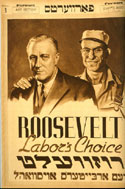| |
|

learn
more

learn
more
|
WELCOME
to the fourth issue of Living History,
the new email newsletter of The American Jewish Historical Society.
Scan below to see the articles in this issue, then click a link
to jump to an item of interest.
we
welcome your feedback |
|
| |
|
|
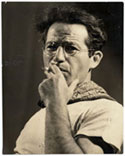 |
|
Honor the life and work of Henry
Roth: author of Call it Sleep,
regarded as one of the greatest American novels of the twentieth
century, and the four volume Mercy of
a Rude Stream novels referred to as an "immense
achievement" by the New York Times.
Celebrate his Centenary. Attend the
Symposium featuring noted scholars and authors in conversation
and readings from his work. |
|
|
|
|
|
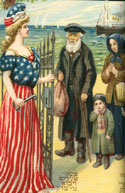 |
|
On March 6, 2006, the American Jewish
Historical Society's version of the Library of Congress exhibition,
"From Haven to Home: 350 Years of American Jewish Life,"
will relocate to the Society's facility at Hebrew College in
Newton Centre, MA. During its four-month stay at the Moakley
United States Courthouse in downtown Boston, an estimated 22,000
individuals viewed the exhibition, including as many as 5,000
school children. The Boston Globe and other area newspapers
gave the exhibition unanimous praise. |
|
|
learn more
Image from the cover of
The Jewish Immigrant magazine,
HIAS, New York City,
January 1909
|
|
|
|
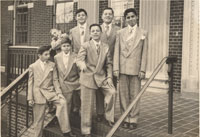 |
|
Between now and June of 2006, the
AJHS will present its latest exhibition at the Center for Jewish
History in New York. ‘Cradled in Judea’: Jewish
Orphanages in New York, 1860-1960, explores the lives of children
who called New York City’s Jewish orphanages “home.” |
|
|
learn more
Bar Mitzvah boys at
the Pride of Judea, c. 1950
American Jewish Historical Society
|
|
|
|
 |
|
Hot off the press, the Society’s
2006 Update Edition of Jewish Major Leaguers baseball cards
features Jewish major league baseball players who debuted in
2005, newly discovered old time players, players from the women’s
league of the 1940’s, pioneer owners and broadcasters,
and many more. This 53-card set is a follow-up to the hit 142
card original series of 2003, the first of its kind to honor
Jewish baseball stars. |
|
|
|
|
|
|
 |
Symposium: Celebrating The 100th Birthday
of Henry Roth 1906 – 1995
Tuesday, February 7, 2006, 5:30 – 9:00 p.m.
The New York City Public Library,
42nd Street and Fifth Avenue
5:30 – 6:30 p.m.
Reception for students, panelists, guests, and attendees.
6:45 – 7:00 p.m.
Introduction and welcome to guests and participants; remarks by
members of the Centennial Committee and from Henry Roth's son, Hugh
Roth.
7:00 – 7:15 p.m.
Professor Steven Kellman will speak about his new biography of Henry
Roth entitled Redemption: The Life of Henry Roth with some special
references to Mr. Roth's connection to CCNY.
7:15 – 7:30 p.m.
Readings of selected passages from the works of Henry Roth.
7:30 – 9:00 p.m.
Two successive Roundtable discussions
The Centenary Celebration is co-sponsored by City College of New
York, the American Jewish Historical Society, the Dorot Jewish Division
of the New York Public Library, and Lawrence I. Fox, Trustee, the
Henry Roth Literary Property Trust.
This is a free event but pre-registration at freidus@nypl.org
or (212) 930-0601 is requested.
Further information at ajhs.org/publications/symposium.cfm
back to top
|
|
 |
|
|
|
|
|
“Roosevelt Labor’s
Choice.”
New York Forvertz,
November 1, 1936.
|
To visit this retrospective view of 350 years of the American Jewish
experience, please visit the Society in the Gann Library of Hebrew
College at 160 Herrick Road, Newton Centre, MA 02459 between March
6 and August 31, 2006. Hours are Monday – Thursday, 9:30 a.m.
– 3:30 p.m., and Friday, 9:30 a.m. – noon.
back to top
|
|
 |
“Get
up, say your prayers, get your breakfast, go to school, come back,
study your lessons, study Hebrew, get your supper and go to bed.
Very little play, very little play!” So goes the routine at
the first Jewish orphanage in America, at One Lamartine Place on
what is now 29th Street in Manhattan, which was opened in 1860.
The first Jewish group to care for vulnerable Jewish youth in New
York City was the Hebrew Benevolent Society, which raised $300 to
“ameliorate the condition of the unfortunate of the [Jewish]
faith.”
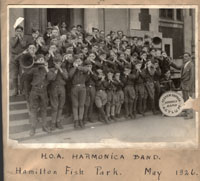 |
|
 |
|
Hebrew Orphan Asylum Harmonica Band
Hamilton Fish Park,
c. 1926
American Jewish Historical Society |
|
Hebrew
Orphan Asylum hiker, c. 1925
American Jewish Historical Society |
On January 17, 2006, the Society will opened its newest exhibition:
“Cradled in Judea”: Jewish Orphanages in New York, 1860-1960.
When the first Jewish orphanages were established, government agencies
provided few social services other than the most basic distribution
of food, wood or coal to the poor. Jewish philanthropies had to
meet the needs of their most vulnerable members or risk losing them
to the streets or to Christian missions funded specifically to convert
Jews in need of assistance. The arrival of 80,000 or more Yiddish-speaking
Jewish immigrants into New York City every year during the 1890s
greatly increased the number of homeless and runaway Jewish youth.
Rather than write them off, the city’s mostly German-Jewish
leadership elite tried through residential institutions to provide
“ideal homes” for the orphaned, abandoned or voluntarily-surrendered
children of their less fortunate coreligionists –to “cradle
them in Judea” by teaching vocational and academic skills,
religion and decorum that would make them useful and independent
adults
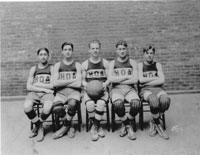 |
|
 |
|
Hebrew Orphan Asylum
Basketball team, c. 1922
American Jewish Historical Society
|
|
Bugler,
Hebrew Orphan Asylum, ca. 1920
American Jewish Historical Society |
“Cradled in Judea” is based on the Society’s own
holdings, which include the records of the Brooklyn Hebrew Orphan
Asylum, Home for Hebrew Infants, Hebrew Orphan Asylum, Hebrew Sheltering
Guardian Society of New York, Hebrew Infant Asylum of New York City,
Hebrew National Orphan Home, Hartman-Homecrest Records, the Pride
of Judea, the records of the Seligman Solomon Society and the papers
of Hyman Bogen. The exhibition features photographs, original documents,
artifacts from the orphanages and from the personal collections
of many of their graduates, as well as oral history interviews with
the orphans themselves.
back to top |
|
 |
 There are 13 cards in the set recognizing the Jewish Major Leaguers
who took the field in 2005, believed to be the most to ever appear
in one season in history. These players include Shawn Green, Brad
Ausmus, Mike Lieberthal, Al Levine, Scott Schoeneweis, Jason Marquis,
Gabe Kapler, John Grabow, Kevin Youkilis, Adam Stern, Craig Breslow,
Adam Greenberg, and Scott Feldman. The set also includes “newly
discovered” Jewish players of the past, including Hall of
Fame player-manager Lou Boudreau (whose mother was Jewish), Jose
Bautista, Lefty Weinert, Jacob Atz, Bob Davis, and Jacob Livingston.
One card features a team photo of the Israeli National Baseball
Team.
There are 13 cards in the set recognizing the Jewish Major Leaguers
who took the field in 2005, believed to be the most to ever appear
in one season in history. These players include Shawn Green, Brad
Ausmus, Mike Lieberthal, Al Levine, Scott Schoeneweis, Jason Marquis,
Gabe Kapler, John Grabow, Kevin Youkilis, Adam Stern, Craig Breslow,
Adam Greenberg, and Scott Feldman. The set also includes “newly
discovered” Jewish players of the past, including Hall of
Fame player-manager Lou Boudreau (whose mother was Jewish), Jose
Bautista, Lefty Weinert, Jacob Atz, Bob Davis, and Jacob Livingston.
One card features a team photo of the Israeli National Baseball
Team.
Jewish women who played in the All-American Girls Professional Baseball
League (AAGPBL) have cards in this new set – Thelma “Tiby”
Eisen, Anita Foss, and Blanche Schachter. (The tale of this league
was told in Penny Marshall’s film, “A League of their
Own”). The new set, handsomely packaged in a clear plastic
box, is available ONLY THROUGH AJHS. You can order online at www.ajhs.org
or call toll free at (866) 740-8013. The set sells for $36 plus
shipping and handling.
back to top
|
| |
To
unsubscribe click here.
Published by The American Jewish Historical Society
© 2006 The American Jewish Historical Society. All rights reserved. |
|
|






